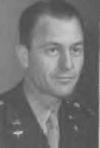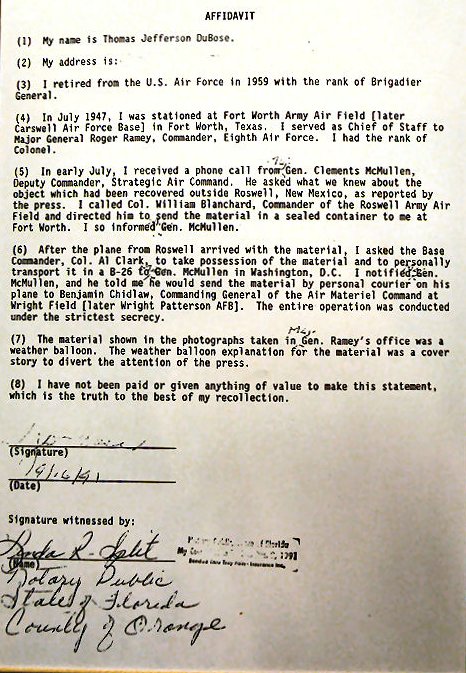Thomas Jefferson DUBOSE(Thomas DUBOSE, Thomas J. DUBOSE, Thomas Jefferson DUBOSE, Col. DUBOSE, Colonel DUBOSE). |

|
Please, before asking any question or sending any comment or criticism, read this.
Born May 10, 1902
Social security number 460-64-3419
USAF, Colonel in 1947
USAF Service number 470A
This is the Thomas J. Dubose biography on the US Air Force website as of 2017, at
http://www.af.mil/About-Us/Biographies/Display/Article/107215/brigadier-general-thomas-j-du-bose/
|
BRIGADIER GENERAL THOMAS J. DU BOSE Died February 24,1992 Thomas Jefferson Du Bose was born in 1902 in San Antonio, Texas. He graduated from Central High School, Oklahoma City, in 1922 and attended the University of Oklahoma from 1923 until 1924. In 1925 he entered the U.S. Military Academy and graduated from West Point June 13, 1929. In September 1929, Second Lieutenant Du Bose entered primary flying school at March Field, Calif. He later graduated from the Advanced Flying School at Kelly Field, Texas and was transferred to the Army Air Corps March 14, 1931. He served as flight instructor at Kelly Field until June 1931 when he joined the 3rd Pursuit Squadron at Clark Field, Philippine Islands. In 1934 First Lieutenant Du Bose returned to Kelly Field as a flight instructor. He was later promoted in June 1939 to captain. The next year Captain Du Bose became director of training at Moffett Field, Calf., and was promoted. Major Du Bose assumed like responsibilities as director of training at Merced, Calif. in October 1941. While serving there he was elevated to the rank of lieutenant colonel and a year later he was appointed chief of Flying Training Section at Headquarters U.S. Army Air Forces with the rank of full colonel. Colonel Du Bose served as chief of the Air Crew Training Division from March to December 1943, when he was appointed deputy to the assistant chief of air staff for training. Colonel Du Bose assumed command of the 316th Bomb Wing at Colorado Springs, Colo., in December 1944. The following July he took that wing to the Asiatic-Pacific theater of operations. In January 1946 he was named assistant chief of staff for plans of the Pacific Air Command at Manila, Philippine Islands. In June 1946 Colonel Du Bose became deputy assistant chief of staff for operations of Strategic Air Command at Bolling Field, Washington, D.C. From August to October 1946 he commanded the advance headquarters echelon of Strategic Air Command at Colorado Springs, Colo. He was then assigned to the 8th Air Force at Forth Worth, Texas with which he served successively as assistant chief of staff for personnel, chief of staff and deputy commander. In February 1948 Colonel Du Bose was named deputy commander of Air Task Group 7.4, the Air Force part of Joint Task Force 7 which constructed a proving ground for the Atomic Energy Commission at Eniwetok and later assisted the Atomic Energy Commission in the conduct of the first series of tests of atomic weapons. In May 1948 after his return to the United States, he rejoined the 8th Air Force as chief of staff. Colonel Du Bose later entered the National War College in August 1948 and graduated in June 1949. Two months later Colonel Du Bose assumed command of the 1602nd Air Transport Wing at Wiesbaden, Germany. On Aug. 13, 1952 Colonel Du Bose returned to the United States and assumed command of the Air Rescue Service at Washington, D.C. Four days later Aug. 17, 1952, he was promoted to the rank of brigadier general. General Du Bose, a rated command pilot since 1942, also is a rated combat observer and an aircraft observer. INTERESTS A former tennis and squash player, General Du Bose is an avid sports enthusiast. This enthusiasm is combined with his active photographic hobby. Among his many sports friends, Mr. Leo Durocher is perhaps the best known. They trace their friendship from 1945. DECORATIONS AND MEDALS American Defense Service Medal OPINIONS, TASTES AND EVALUATIONS General Du Bose is an enthusiast for Mexican style foods, or as he put it "anything hot." He is an amateur cook, having learned the art when he became interested in cooking during his tour of duty in Texas. His tastes in reading are historical novels or actual historical documents. His personal philosophy of life, "live and let live," particularly will suits him as commander of a humanitarian organization that has as its motto "That Others May Live." General Du Bose stresses loyalty and honesty - he emphasizes this and demands it of all who associate with him. "Of all the generals I know, he is by far the fairest and most appreciative of your work." This was said by one of his staff officers recently about General Du Bose. A colonel on his staff also recently stated, "the general tells you what he wants and then let's you do it without interference." CIVIC AND RELIGIOUS ACTIVITIES Member, Military Order, World War Member, American legion Post I, Paris, France. |

|
|
AFFIDAVIT (1) My name is Thomas Jefferson Dubose (2) My address is: [Confidential] (3) I retired from the U.S. Air force in 1959 with the rank of Brigadier General. (4) In July 1947, I was stationed at Fort Worth Army Air Field in Fort Worth, Texas. I served as Chief of Staff to Major General Roger Ramey, Commander, Eight Air Force. I had the rank of Colonel. (5) In early July, I received a phone call from Maj. Gen. Clements McMullen, Deputy Commander, Strategic Air Command. He asked what we knew about the object which had been recovered outside Roswell, New Mexico, as reported in the press. I called Col. William Blanchard, Commander of the Roswell Army Air Field and directed him to send the material in a sealed container to me at Fort Worth. I so informed Maj. Gen. McMullen. (6) After the plane from Roswell arrived with the material, I asked the Base Commander, Col. Al Clark, to take possession of the material and to personally transport it in a B-26 to Maj. Gen. McMullen in Washington, D.C. I notified Maj. Gen. McMullen, and he told me he would send the material by personal courier on his plane to Benjamin Chidlaw, Commanding General of the Air Material Command at Wright Field [later Wright Patterson AFB]. The entire operation was conducted under the strictest secrecy. (7) The material shown in the photographs taken in Maj. Gen. Ramey's office was a weather balloon. The weather balloon explanation for the material was a cover story to divert the attention of the press. (8) I have not been paid or given anything of value to make this statement, which is the truth to the best of my recollection. Signed: T. J. Dubose Signature witnessed by: |
Under construction.
Please see the MUFON Journal article of 1991 in which Jaime Shandera published about his inteviews of Gen. DuBose.
Col. DuBose's MemoriesWe have been hearing for some time that Gen. (then Col.) DuBose has stated that there was a cover-up and that the debris was swapped. This sounds damning! However.... Schmitt and Friedman went to interview DuBose in Aug 1990 when DuBose was almost 90 years of age. They used regressive hypnosis on him to try to "help" his 43 year old memories.
Apparently Schmitt and Friedman didn't show the photos of the debris to DuBose when they interviewed him. Schmitt indicated that they asked DuBose if he had ever seen the real Roswell debris, and he answered with "a resounding NO!!!" Was the debris on Ramey's floor the debris from Roswell? DuBose answered "No." But when Shandera interviewed DuBose, both by phone and in person, DuBose looked at the photos and stated that they were the debris that Marcel had brought with him from Roswell! Remember, according to crash proponents, Marcel was supposed to have brought with him the "real" debris, and Ramey's office had then substituted the balloon debris for the press. But if, as some have suggested, the balloon had been substituted for the "real" debris, no one has yet answered where Ramey got an ML-307 and rubber from a weather balloon that had been out in the sun for three weeks!
So if they were so rare and not in use in Ft. Worth and Roswell, where did "they" find parts of one that had been out in the sun for three weeks to substitute for the "real" debris? |
Source:
| Version: | Created/Changed by: | Date: | Change Description: |
|---|---|---|---|
| 1.0 | Patrick Gross | July 21, 2003 | First published. |
| 1.1 | Patrick Gross | May 1, 2017. | Addition of the biography by the US Air Force; the "Roswell Files" website article. |
| 1.2 | Patrick Gross | May 18, 2017. | Addition of the "Jaime Shandera, 1991" part. |